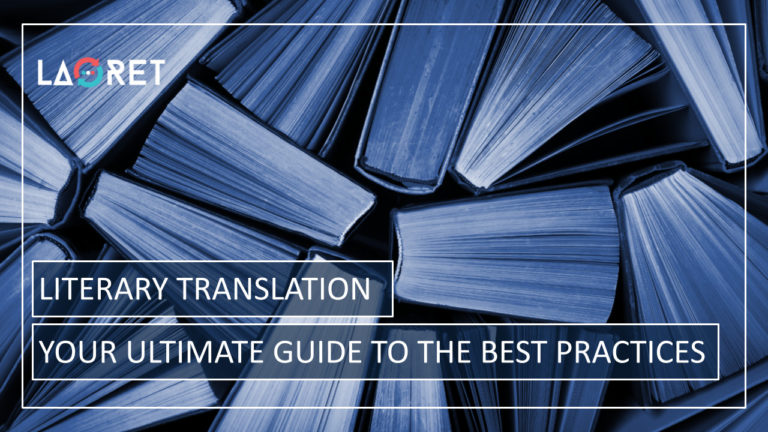Literary Translation: Your Ultimate Guide To The Best Practices
The publishing industry is a highly competitive one, and when it comes to literary translations, there are a set of best practices that ensure the piece of literature will connect with multilingual markets.
Literary work includes all fictional content. This type of work is written not only to convey a certain message but also to be part of an art form. This can include novels, poems, plays, short stories, and so on. What you can already guess is that this level of artistic expression will bring with it its own set of challenges.
So, how does a translator make sure that the reader will be immersed in the same way as the target language? How is quality maintained? And can a translator get in the way of providing a great translation? Find all the answers!
What Makes A Quality Literary Translator?
The biggest challenge of literary translation is not whether to get each word and phrase right, it is about engaging the reader in the same world and sensation as the original text does. A literary translator should be able to analyze the work artistically and rhetorically, but also understand the deeper meaning that hides behind a text, with the author’s style, tone, culture, and originality intact. In essence, a literary translator is reconstructing the original work and assembling it in a new linguistic and cognitive framework that suits the target audience and remains loyal to the author’s voice. For this reason, a literary translator should:
- Be native to the country and region so they can find suitable translations for colloquialisms, formal versus informal usage, jargon, and so on. For example, when translating into Spanish, it is important to keep in mind that the Spanish language comes in many different forms and dialects. Spanish in Spain will require a vastly different type of vocabulary than Spanish in Latin America, and even within Latin America, there are country-specific and regional differences that include words and linguistic choices that can differ depending on location.
- Have years of experience in literary translation as well as formal training in the translation of literature, not just a general translation qualification. The added bonus of years of experience will not only be a track record, but also the fact that the linguist will be aware of their strengths in certain genres and styles and be capable of making smart project decisions.
- Possess a high level of creativity and can apply their best judgment when there is no accurate variant available in the target language.
What About Subjectivity?
To zone in on the latter point a little more, yes, creativity matters greatly, but creativity sometimes comes with some level of subjectivity as well. A linguist’s personal perception and to what degree it should interfere with the actual translation has caused quite the debate. In Synthesis Writing in a Foreign Language, Alexandra-Valeria Popescu, and Marion-Ivonne Cohen-Vida state that literary translation is a creation in itself, and a linguist’s subjectivity can simply offer a different interpretation that is equally valuable.1 Professor of Comparative Literary Studies Susan Bassnett, on the other hand, poses the question of whether the translator actually should feel like they are giving birth to something new.2
Whichever side of the debate you belong to, subjectivity is inevitable, but only a qualified literary translator will not dip into their subjective perception excessively and keep their work as objective as possible and true to the author’s intent. For this reason, a skilled literary linguist will look beyond the words on the page and take the author’s experiences and views into consideration. This way, the translator can approach their job more as a researcher and language / culture expert, and less as a co-creator. We’ll talk more about this later on!

Literary Translation Best Practices Step By Step
So, what are some of the ways in which a qualified literary translation is obtained? We have focused on the importance of a translator’s skills and knowledge, but in order to ensure quality, there are certain best practices and techniques that should be respected.
First of all, any Language Service Provider (LSP) worth their salt will add Quality Control to every part of the translation journey. This all starts with the Translation, Editing and Proofreading (TEP) Process, which ensures the best possible linguistic quality. Let’s deconstruct this process and look a little bit more closely at the details involved in literary translation.
Know The Book And The Author Before You Translate
Before starting the actual translation process, some prep-work is needed. Before reading the work they are supposed to translate, it is beneficial for a linguist to, like we stated before, research the author. If possible, it is best to connect with the author directly! This will not only mitigate the above-mentioned issue of subjectivity, but will also deepen the translator’s connection with the work and enable them to make smarter choices. The best scenario doesn’t only allow a linguist to talk to the author prior to translation, but also during the translation process.
Language, Context, And Audience: How To Keep Them True To Form
During the translation stage, there are certain techniques that will be leveraged to convey quality as well as the original author’s intention.
Literary Translation is all about adaptation and making sure that the text is understandable for the target audience. This means that certain intuitive choices will need to be made if there are words for which there is no direct translation available. Here, a certain level of problem-solving and creativity will be required, since while the words can certainly be different, the meaning cannot be.
The technique of compensation ensures that the translated work will adhere to the internal logic of the original by, for example, placing certain paragraphs or bits of information in another location. This technique is created not so that the translator can move pieces of text as they please, but in order to make sure that none of the source text will be excluded.
Another popular technique among literary translators is that of borrowing. When an English term used in the text is a very popular term in the target region, the translator may make the choice to maintain the original English word rather than to opt for a translation that is less used within their culture and language.
Desktop Publishing And Design
Desktop Publishing and Design are other factors that should not be forgotten when transiting literary work. Desktop Publishing experts will make sure that the format of the translated text will follow the original. This can be extra important when the author has made some structural choices that impact the meaning and intention of the content.
Take Mark Z. Danielewski’s House of Leaves as an example. It contains various colors and font changes to communicate nuances in the story and also inserts pieces of content in creative ways by the use of frames, collages, and even pages with only a few words present on them. All of these will not only need to be reproduced perfectly but do so in a way that conveys the exact same meaning in different language versions.
Next to the book’s actual structure, the cover design will also need some consideration. The ideal design will, just like the content, bring together the author’s intention and the preferences of the audience the translation is intended for.
What Makes A Book Sell In Your Target Locale?
Of course, literary translation doesn’t end with the book. Marketing materials will also need to be translated and adapted to each region for optimal impact. For this, localization, transcreation and copywriting services will be needed so that the personal messaging can be effective, engaging, and moving in any country.
But there is more! What about the book descriptions offered on eCommerce Platforms such as Amazon? We’ll come right out and say it, you can’t simply copy/paste a generic book description and have that be that. There are targeted multilingual marketing strategies and a profound understanding of your target audience as well as the platform and search engines. Descriptions can serve as an effective way to engage readers as well as tell the platform and search engines what you are all about. Want to learn more about how you can make sure your book translation will rank? Check out our blog on Multilingual Book Summarization: Increase Engagement And Conversion!
Conclusion
Literary Translation requires a very specific kind of expertise that is not only linguistic, but also includes creative choices that protect the integrity of the original work and ensure that the same emotional impact is maintained in the translated work. For this reason, literary translators should be highly experienced and follow a strict set of best practices, but also be skilled communicators and researchers who know how to understand the author and use this knowledge to make the best translation choices.
At Laoret, we hire only native, in-country professionals with experience in providing literary translations where creativity and cultural potency are prioritized. Reach out to us! We are available 24/7.






